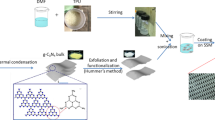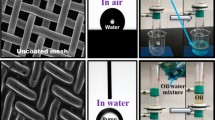Abstract
Organic–inorganic hybrid membranes are attractive material for oil/water separation. Here, a hydrophilic and oleophobic membrane was prepared by coating chitosan (CTS) and polyvinyl alcohol (PVA) on the surface of copper mesh using glutaraldehyde (GA) as crosslinking agent. After introduction of TiO2 nanoparticles, the surface roughness of the composite film was increased and a superhydrophilicity and underwater superoleophobicity surface was obtained due to the enhancement in wettability. The as-prepared superhydrophilic membrane was characterized by SEM, FTIR, XRD, and its surface wetting behavior was measured by contact angle meter. The effect of CTS, PVA, GA, and TiO2 on the microstructure, underwater oil contact angle, and sliding angle was comprehensively evaluated. Then, the super hydrophilic membrane was used for oil/water separation, a separation efficiency (> 99.7%) was obtained with a flux rate of 16,000 L m−2 h−1. The intrusion pressures for all tested oils that the membrane can support are above 1.0 kPa. Significantly, the super hydrophilic membrane exhibited good antiabrasion and anticorrosive properties. After repeated use for 60 times, the separating performances and average permeate fluxes showed no obvious degradation.
Graphical abstract
An organic-inorganic hybrid chitosan (CTS)–polyvinyl alcohol (PVA)-TiO2 coated copper mesh with superhydrophilicity–underwater superoleophobicity was fabricated by one-step solution immersion method and can be used for efficient oil/water separation.









Similar content being viewed by others
References
Mu, L, Yang, S, Hao, B, Ma, P-C, “Ternary Silicone Sponge with Enhanced Mechanical Properties for Oil–Water Separation.” Polym. Chem., 6 (32) 5869–5875 (2015)
Seddighi, M, Hejazi, SM, “Water-Oil Separation Performance of Technical Textiles Used for Marine Pollution Disasters.” Mar. Pollut. Bull., 96 (1) 286–293 (2015)
Hosseinzadeh, H, Mohammadi, S, “Synthesis of a Novel Hydrogel Nanocomposite Coated on Cotton Fabric for Water-Oil Separation.” Water Air Soil Pollut., 225 (9) 2115 (2014)
Rinaldi, A, Da Silva, MR, “Degradation of BTX in Contaminated Soil by Using Hydrogen Peroxide (H2O2) and Potassium Permanganate (KMnO4).” Water Air Soil Pollut., 217 (1–4) 245–254 (2011)
Thew, M, “Hydrocyclone Redesign for Liquid–Liquid Separation.” Chem. Eng., 427 17–23 (1986)
Yuan, J, Liu, X, Akbulut, O, Hu, J, Suib, SL, Kong, J, Stellacci, F, “Superwetting Nanowire Membranes for Selective Absorption.” Nat. Nanotechnol., 3 (6) 332–336 (2008)
Thanikaivelan, P, Narayanan, NT, Pradhan, BK, Ajayan, PM, “Collagen Based Magnetic Nanocomposites for Oil Removal Applications.” Sci. Rep., 2 230 (2012)
Gu, J, Jiang, W, Wang, F, Chen, M, Mao, J, Xie, T, “Facile Removal of Oils from Water Surfaces Through Highly Hydrophobic and Magnetic Polymer Nanocomposites.” Appl. Surf. Sci., 301 492–499 (2014)
Gupta, VK, Carrott, PJM, Riberiro Carrott, MML, Suhas, “Low-cost Adsorbents: Growing Approach to Wastewater Treatment—A Review.” Crit. Rev. Environ. Sci. Technol., 39 (10) 783–842 (2009)
Cervin, NT, Aulin, C, Larsson, PT, Wagberg, L, “Ultra Porous Nanocellulose Aerogels as Separation Medium for Mixtures of Oil/Water Liquids.” Cellulose, 19 (2) 401–410 (2011)
Nguyen, DD, Tai, N, Lee, S, Kuo, W, “Superhydrophobic and Superoleophilic Properties of Graphene-Based Sponges Fabricated Using a Facile Dip Coating Method.” Energy Environ. Sci., 5 (7) 7908–7912 (2012)
Chan, YJ, Chong, MF, Hassell, DG, “A Review on Anaerobic-Aerobic Treatment of Industrial and Municipal Wastewater.” Chem. Eng. J., 155 (1) 1–18 (2009)
Singh, V, Purkait, MK, Das, C, “Cross-Flow Microfiltration of Industrial Oily Wastewater: Experimental and Theoretical Consideration.” Sep. Sci. Technol., 46 (8) 1213–1223 (2011)
Van der Bruggen, B, Vandecasteele, C, Van Gestel, T, Doyen, W, Leysen, R, “A Review of Pressure-Driven Membrane Processes in Wastewater Treatment and Drinking Water Production.” Environ. Prog., 22 (1) 46–56 (2003)
Wang, S, Feng, L, Liu, H, Sun, T, Zhang, X, Jiang, L, Zhu, D, “Manipulation of Surface Wettability Between Superhydrophobicity and Superhydrophilicity on Copper Films.” ChemPhysChem, 6 (8) 1475–1478 (2005)
Ma, M, Mao, Y, Gupta, M, Gleason, KK, Rutledge, GC, “Superhydrophobic Fabrics Produced by Electrospinning and Chemical Vapor Deposition.” Macromolecules, 38 (23) 9742–9748 (2005)
Tuteja, A, Choi, W, Ma, M, Mabry, JM, Mazzella, SA, Rutledge, GC, McKinley, GH, Cohen, RE, “Designing Superoleophobic Surfaces.” Science, 318 (5856) 1618–1622 (2007)
Xue, Z, Cao, Y, Liu, N, Feng, L, Jiang, L, “Special Wettable Materials for Oil/Water Separation.” J. Mater. Chem. A, 2 (8) 2445–2460 (2014)
Feng, L, Zhang, Z, Mai, Z, Ma, Y, Liu, B, Jiang, L, Zhu, D, “A super-hydrophobic and Super-Oleophilic Coating Mesh Film for the Separation of Oil and Water.” Angew. Chem. Int. Ed., 43 (15) 2012–2014 (2004)
Wang, H, Wang, E, Liu, Z, Gao, D, Yuan, R, Sun, L, Zhu, Y, “A Novel Carbon Nanotubes Reinforced Superhydrophobic and Superoleophilic Polyurethane Sponge for Selective Oil–Water Separation Through A Chemical Fabrication.” J. Mater. Chem., 3 (1) 266–273 (2014)
Li, J, Li, D, Li, W, She, H, Feng, H, Hu, D, “Facile Fabrication of Three-Dimensional Superhydrophobic Foam for Effective Separation of Oil and Water Mixture.” Mater. Lett., 171 228–231 (2016)
Cao, Y, Chen, Y, Liu, N, Lin, X, Feng, L, Wei, Y, “Mussel-Inspired Chemistry and Stöber Method for Highly Stabilized Water-In-Oil Emulsions Separation.” J. Mater. Chem., 2 (48) 20439–20443 (2014)
Zhang, F, Zhang, WB, Shi, Z, Wang, D, Jin, J, Jiang, L, “Nanowire-Haired Inorganic Membranes with Superhydrophilicity and Underwater Ultralow Adhesive Superoleophobicity for High-Efficiency Oil/Water Separation.” Adv. Mater., 25 (30) 4192–4198 (2013)
Zhang, E, Cheng, Z, Lv, T, Qian, Y, Liu, Y, “Anti-corrosive Hierarchical Structured Copper Mesh Film with Superhydrophilicity and Underwater Low Adhesive Superoleophobicity for Highly Efficient Oil–Water Separation.” J. Mater. Chem., 3 (25) 13411–13417 (2015)
Xue, Z, Wang, S, Lin, L, Chen, L, Liu, M, Feng, L, Jiang, L, “A Novel Superhydrophilic and Underwater Superoleophobic Hydrogel-Coated Mesh for Oil/Water Separation.” Adv. Mater., 23 (37) 4270–4273 (2011)
Liu, M, Wang, S, Wei, Z, Song, Y, Jiang, L, “Bioinspired Design of a Superoleophobic and Low Adhesive Water/Solid Interface.” Adv. Mater., 21 (6) 665–669 (2009)
Zhang, W, Zhu, Y, Liu, X, Wang, D, Li, J, Jiang, L, Jin, J, “Salt-Induced Fabrication of Superhydrophilic and Underwater Superoleophobic PAA-g-PVDF Membranes for Effective Separation of Oil-in-Water Emulsions.” Angew. Chem. Int. Ed., 53 (3) 856–860 (2014)
Liu, J, Li, P, Chen, L, Feng, Y, He, W, Yan, X, Lu, X, “Superhydrophilic and Underwater Superoleophobic Modified Chitosan-Coated Mesh for Oil/Water Separation.” Surf. Coat. Technol., 307 171–176 (2016)
Li, G, Zhao, Y, Lv, M, Shi, Y, Cao, D, “Super Hydrophilic Poly(Ethylene Terephthalate) (PET)/poly(vinyl alcohol) (PVA) Composite Fibrous Mats with Improved Mechanical Properties Prepared via Electrospinning Process.” Colloids Surf., A, 436 417–424 (2013)
Li, J, Yan, L, Hu, W, Li, D, Zha, F, Lei, Z, “Facile Fabrication of Underwater Superoleophobic TiO2 Coated Mesh for Highly Efficient Oil/Water Separation.” Colloids Surf., A, 489 441–446 (2016)
Fan, J, Duan, J, Yu, Z, Wu, D, Zhu, H, “Oleophobicity of Chitosan/Micron-alumina-Coated Stainless Steel Mesh for Oil/Water Separation.” Water Air Soil Pollut., 227 (5) 163 (2016)
Zhang, S, Lu, F, Tao, L, Liu, N, Gao, C, Feng, L, Wei, Y, “Bio-Inspired Anti-Oil-Fouling Chitosan-Coated Mesh for Oil/Water Separation Suitable for Broad pH Range and Hyper-Saline Environments.” ACS Appl. Mater. Interfaces., 5 (22) 11971–11976 (2013)
Yuan, T, Shao, Q, Hu, J, Wang, F and Tu, W, “Effect of the Intermediate Layer–Core Ratio on the Morphology and Opacity Ability of Hollow Latex Particles.” J. Appl. Polym. Sci., 132(30) (2015)
Gondal, MA, Sadullah, MS, Dastageer, MA, Mckinley, GH, Panchanathan, D, Varanasi, KK, “Study of Factors Governing Oil–Water Separation Process Using TiO2 Films Prepared by Spray Deposition of Nanoparticle Dispersions.” ACS Appl. Mater. Interfaces., 6 (16) 13422–13429 (2014)
Chaudhary, JP, Vadodariya, N, Nataraj, SK, Meena, R, “Chitosan-Based Aerogel Membrane for Robust Oil-In-Water Emulsion Separation.” ACS Appl. Mater. Interfaces., 7 (44) 24957–24962 (2015)
Tian, D, Zhang, X, Wang, X, Zhai, J, Jiang, L, “Micro/Nanoscale Hierarchical Structured ZnO Mesh Film for Separation of Water and Oil.” Phys. Chem. Chem. Phys., 13 14606–14610 (2011)
Bai, H, Liu, Z, Sun, DD, “Hierarchically Multifunctional TiO2 Nano-Thorn Membrane for Water Purification.” Chem. Commun., 46 6542–6544 (2010)
Marmur, A, “Wetting on Hydrophobic Rough Surfaces: To Be Heterogeneous or Not To Be?” Langmuir, 19 (20) 8343–8348 (2003)
Tian, D, Xiaofang, Z, Yu, T, Yue, W, Wang, X, Zhai, J, Jiang, L, “Photo-induced Water–Oil Separation Based on Switchable Superhydrophobicity–Superhydrophilicity and Underwater Superoleophobicity of the Aligned ZnO Nanorod Array-Coated Mesh Films.” J. Mater. Chem., 22 19652–19657 (2012)
Tan, BYL, Juay, J, Liu, Z, Sun, D, “Flexible Hierarchical TiO2/Fe2O3 Composite Membrane with High Separation Efficiency for Surfactant-Stabilized Oil–Water Emulsions.” Chem. Aasian J., 11 561–567 (2016)
Bharti, B, Kumar, S, Kumar, R, “Superhydrophilic TiO2 Thin Film by Nanometer Scale Surface Roughness and Dangling Bonds.” Appl. Surf. Sci., 364 51–60 (2016)
Yi, XS, Yu, SL, Shi, WX, Wang, S, Jin, LM, Sun, N, Ma, C, Sun, LP, “Separation of Oil/Water Emulsion Using Nano-Particle (TiO2/Al2O3) Modified PVDF Ultrafiltration Membranes and Evaluation of Fouling Mechanism.” Water Sci. Technol., 67 (3) 477–484 (2013)
Fu, X, “Synthesis and Optical Absorpition Properies of Anatase TiO2 Nanoparticles via a Hydrothermal Hydrolysis Method.” Rare Metal Mater. Eng., 44 (5) 1067–1070 (2015)
Liu, HG, Liu, Z, Yang, M, He, QY, “Surperhydrophobic Polyurethane Foam Modified by Graphene Oxide.” J. Appl. Polym. Sci., 130 (5) 3530–3536 (2013)
Gunatilake, UB, Bandara, J, “Fabrication of Highly Hydrophilic Filter Using Natural and Hydrothermally Treated Mica Nanoparticles for Efficient Waste Oil–Water Separation.” J. Environ. Manage., 191 96–104 (2017)
Pan, Q, Wang, M, Wang, H, “Separating Small Amount of Water And Hydrophobic Solvents by Novel Superhydrophobic Copper Meshes.” Appl. Surf. Sci., 254 (18) 6002–6006 (2008)
Kim, JH, Kim, JY, Lee, YM, Kim, KY, “Properties and Swelling Characteristics of Cross-Linked Poly(Vinyl Alcohol)/Chitosan Blend Membrane.” J. Appl. Polym. Sci., 45 (10) 1711–1717 (2010)
Kim, SJ, Lee, KJ, Kim, SI, Lee, KB, Park, YD, “Sorption Characterization of Poly(vinyl alcohol)/Chitosan Interpenetrating Polymer Network Hydrogels.” J. Appl. Polym. Sci., 90 (1) 86–90 (2003)
Pethe, GB, Yaul, AR, Aswar, AS, “Synthesis, Characterization, Electrical and Catalytic Studies of Some Coordination Compounds Derived from Unsymmetrical Schiff Base Ligand.” Bull. Chem. Soc. Ethiop., 29 (3) 387–397 (2015)
Fan, X, Lin, L, Dalsin, JL, Messersmith, PB, “Biomimetic Anchor for Surface-Initiated Polymerization From Metal Substrates.” J. Am. Chem. Soc., 127 (45) 15843 (2005)
Han, H, Wu, J, Avery, CW, Mizutani, M, Jiang, X, Kamigaito, M, Chen, Z, Xi, C, Kuroda, K, “Immobilization of Amphiphilic Polycations by Catechol Functionality for Antimicrobial Coatings.” Langmuir, 27 (7) 4010 (2011)
Wenzel, RN, “Resistance of solid surfaces to wetting by water.” Ind. Eng. Chem., 28 (8) 988–994 (1936)
Youngblood, JP, Mccarthy, TJ, “Ultrahydrophobic Polymer Surfaces Prepared by Simultaneous Ablation of Polypropylene and Sputtering of Poly(tetrafluoroethylene) using Radio Frequency Plasma.” Macromolecules, 32 (20) 6800–6806 (1999)
Yin, K, Chu, D, Dong, X, Wang, C, Duan, JA, He, J, “Femtosecond Laser Induced Robust Periodic Nanoripple Structured Mesh for Highly Efficient Oil–Water Separation.” Nanoscale, 9 14229–14235 (2017)
Chen, Z, Zhou, C, Lin, J, Zhu, Z, Feng, J, Fang, L, Cheng, J, “ZrO2-coated Stainless Steel Mesh with Underwater Superoleophobicity by Electrophoretic Deposition for Durable Oil/Water Separation.” J. Sol-Gel. Sci. Technol., 13 1–8 (2017)
Acknowledgments
This work was supported by the National Natural Science Foundation of China (Grant 21175060), and Prospective Joint Research Project: Cooperative Innovation Fund (No. 2050205.1028).
Author information
Authors and Affiliations
Corresponding authors
Electronic supplementary material
Below is the link to the electronic supplementary material.
Rights and permissions
About this article
Cite this article
You, Q., Ran, G., Wang, C. et al. Facile fabrication of superhydrophilic and underwater superoleophobic chitosan–polyvinyl alcohol-TiO2 coated copper mesh for efficient oil/water separation. J Coat Technol Res 15, 1013–1023 (2018). https://doi.org/10.1007/s11998-017-0036-1
Published:
Issue Date:
DOI: https://doi.org/10.1007/s11998-017-0036-1




